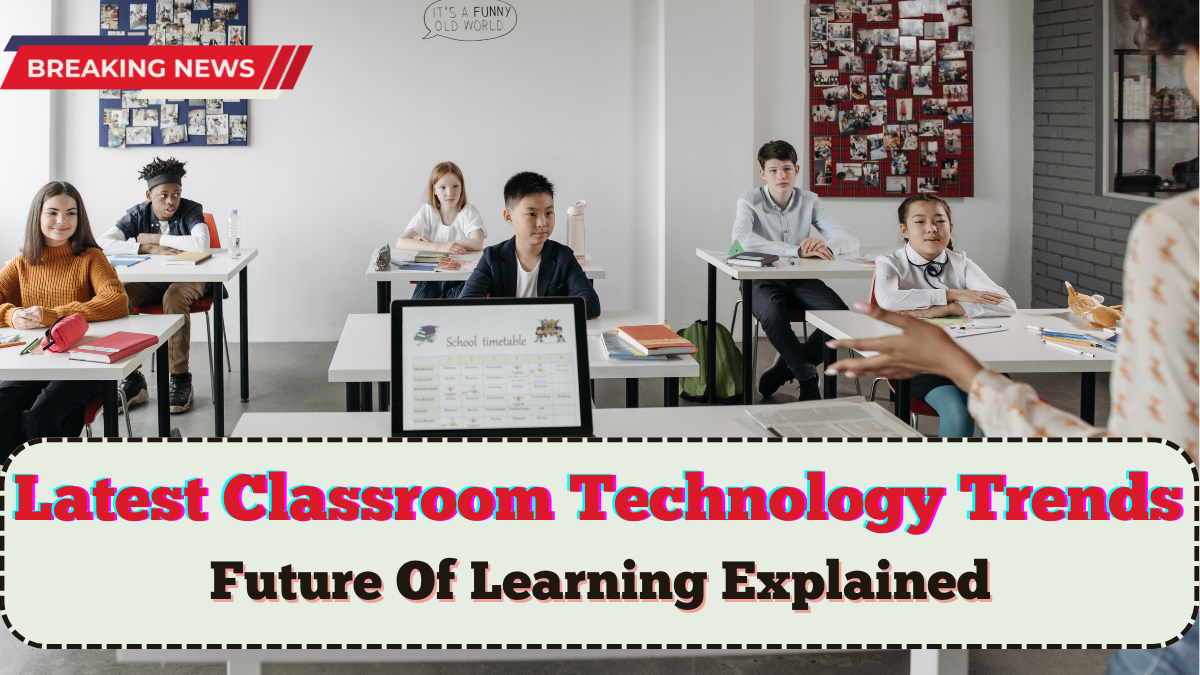The education system in 2025 is witnessing a remarkable transformation—driven not just by pedagogy, but by powerful technology. Across the globe, classrooms are evolving into high-tech hubs where students actively engage, collaborate, and learn in ways never imagined before. The latest classroom technology trends 2025 are redefining how subjects are taught, how teachers interact with students, and how learning outcomes are measured.
No longer limited to blackboards and textbooks, today’s classrooms are equipped with AI tutors, virtual labs, interactive whiteboards, and immersive learning environments. These innovations ensure that education is inclusive, personalized, and future-ready—aligning with the demands of a digitally advanced world.

Why Technology in Classrooms Matters in 2025
The latest classroom technology trends 2025 go far beyond convenience—they are essential for preparing students for a tech-powered future. Today’s learners are digital natives, and integrating technology into classrooms is the key to boosting their engagement and academic performance.
Key benefits include:
-
Personalized learning pathways using AI and adaptive tools
-
Improved collaboration and participation through digital platforms
-
Faster assessments and real-time feedback for better progress tracking
-
Access to global knowledge resources anytime, anywhere
-
Equal learning opportunities for students with disabilities through assistive tech
As a result, smart classrooms are enabling a richer, more inclusive, and far more engaging learning experience for every student.
Top Technology Trends Shaping Classrooms in 2025
Here are the most impactful latest classroom technology trends 2025 that are transforming schools across the world:
1. AI-Powered Learning Platforms
-
Intelligent tutoring systems that personalize content based on student performance
-
Automated grading and feedback systems saving teachers’ time
-
Predictive analytics to identify struggling students early
2. Augmented Reality (AR) & Virtual Reality (VR)
-
Virtual labs for science experiments
-
3D history experiences bringing ancient civilizations to life
-
VR-based skill development modules (e.g., aviation, medicine, engineering)
3. Smartboards and Interactive Displays
-
Real-time quizzes, drawings, simulations, and brainstorming tools
-
Integration with cloud services for storing and sharing classroom data
-
Collaboration features for group projects and flipped learning
4. Gamification and EdTech Apps
-
Leaderboards, badges, and levels to increase engagement
-
Gamified learning apps across subjects like math, coding, and language
-
Real-time score tracking and class-wide competitions
5. Hybrid & Remote Learning Tools
-
Seamless integration of in-person and online learning
-
Use of platforms like Google Classroom, Microsoft Teams, and Zoom Education
-
Access to recorded lessons and cloud-based assignments
6. Voice Assistants & Chatbots
-
AI-powered voice assistants helping with scheduling and instant Q&A
-
Chatbots for student queries, homework reminders, and concept explanations
These tools are not future aspirations—they are already enhancing classrooms in 2025 with proven results.
How Technology Is Improving Teaching and Learning Outcomes
The latest classroom technology trends 2025 are making a measurable impact on both student performance and teacher effectiveness. Let’s look at a side-by-side comparison:
| Key Area | Traditional Classrooms | Tech-Enhanced Classrooms (2025) |
|---|---|---|
| Engagement | Low to Moderate | High, Interactive |
| Assessment Speed | Delayed | Instant, Real-time |
| Personalized Learning | Limited | AI-Driven & Customized |
| Teaching Method | One-size-fits-all | Dynamic & Visual |
| Collaboration | Occasional | Real-time, Multi-device |
| Accessibility | Uneven | Inclusive with Assistive Tech |
This shift ensures that no child is left behind and every learner progresses at their own pace, style, and level.
Role of Teachers in Tech-Driven Classrooms
While technology is advancing rapidly, the role of teachers remains crucial. In 2025, educators are not replaced by tech—they are empowered by it. Teachers are becoming facilitators of digital learning, using tools to:
-
Analyze student performance with dashboards
-
Curate customized learning modules
-
Engage students through creative tech-based activities
-
Manage classroom logistics more efficiently
-
Foster digital literacy and responsible online behavior
Professional development programs are also training teachers to stay updated with these latest classroom technology trends 2025, ensuring smooth integration into daily teaching.
FAQs
What are the latest classroom technology trends 2025?
The latest classroom technology trends 2025 include AI-powered learning, VR/AR integration, smartboards, EdTech apps, gamified learning, hybrid tools, and voice assistants in the classroom.
How does AI help in classroom teaching?
AI customizes lessons, evaluates student performance in real time, and provides adaptive feedback to support personalized learning.
Is classroom technology replacing teachers?
No, it enhances teaching. Technology supports teachers by automating tasks and offering better tools for engagement, but human guidance remains essential.
Are these technologies available in all schools?
While availability varies, most urban and private schools have adopted these technologies. Government initiatives are also promoting digital inclusion in rural schools.
Do students perform better with technology in classrooms?
Yes, multiple studies in 2025 show improved focus, better test scores, and higher engagement when classrooms use modern technology effectively.
Click here to know more.
